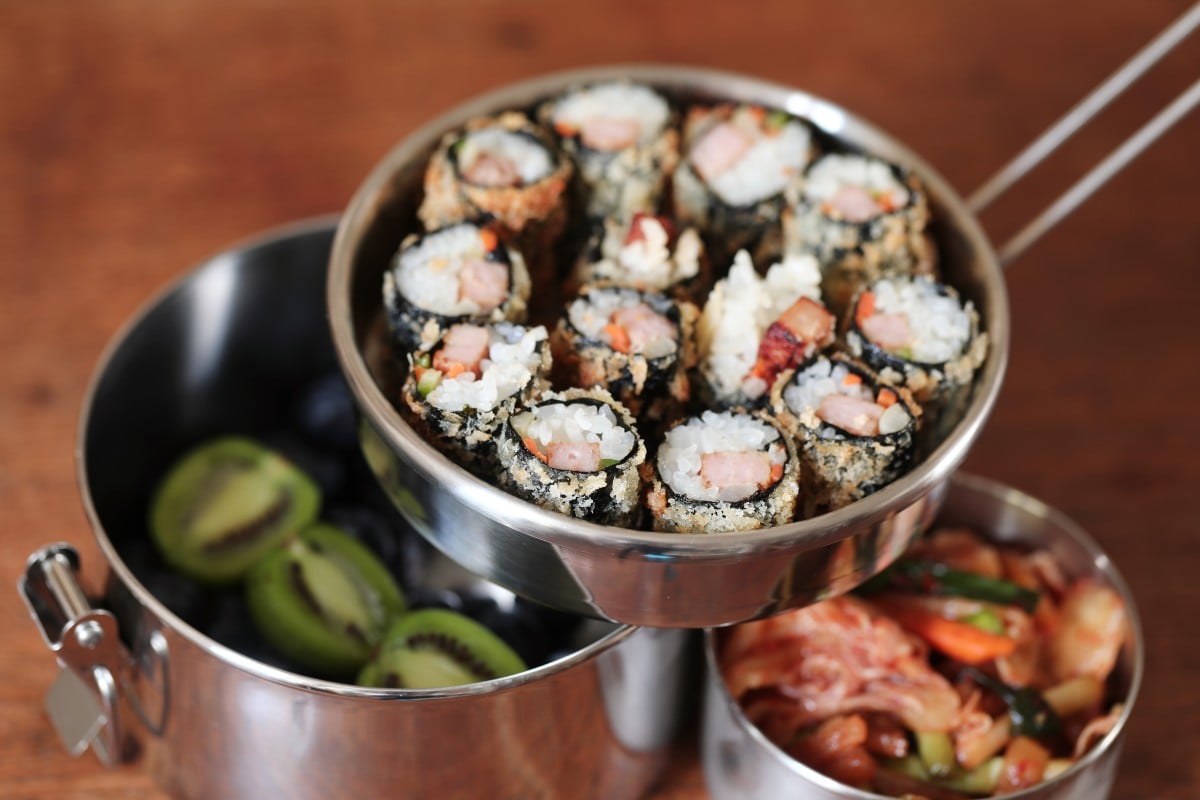
Kimbap (also spelled gimbap) is often called "Korean sushi" but that isn't accurate. If a comparison has to be drawn between the two cuisines, it would be more precise to compare kimbap to Japanese maki - seaweed and rice rolls, rather than sushi in general. Kimbap is seaweed and rice rolled around vegetables and some type of protein. It is child-friendly food that adults enjoy, too. Because the rolls are sturdy and eaten out of hand, they are great for picnics or packed lunches.
Kimbap should be eaten fresh or at room temperature; refrigerating it makes the rice hard. If you want to prepare kimbap the night before and refrigerate it to eat the next day, the best way to heat it is by frying: dip the whole (uncut) rolls in beaten egg, then dredge in panko (Japanese bread crumbs, sold in bags). Fry the rolls in a skillet - this will soften the rice and add a crunchy texture. Cut the fried kimbap into bite-size pieces and pack them in a lunchbox or picnic container.
Luncheon meat might not seem very “foodie” but many of us grew up eating it, and still crave it occasionally. I like the Korean and Japanese brands of luncheon meat. For kimbap, be sure to buy the type that is in a rectangular can, rather than a round one.
A bamboo sushi mat makes rolling the kimbap much easier. In addition to danmuji/takuan (Korean or Japanese semi-dried and pickled radish), carrot and cucumber – which seem to feature in all kimbap – you can also add spinach (blanch the leaves and squeeze out the moisture, then mix with a little sesame oil and salt), chopped kimchi (squeezed dry) and thin egg omelette; if you dislike luncheon meat, substitute cooked beef, pork (such as ham or char siu), surimi (fake crab legs), firm tofu (pan-fried) and even cheese. Kimbap-makers in Korea get pretty creative with the fillings, and you can, too.
Wash and rinse the rice in several changes of water, then drain off as much liquid as possible. Add water so the total weight of rice and water is 1,320g (46½oz). Soak for about 30 minutes, then steam in the rice cooker (or cook in a pan on the stovetop). When the rice is cooked, stir it with a rice paddle and let it cool to room temperature.
Cut the luncheon meat lengthwise into 32 evenly sized sticks. Heat a skillet and rub it lightly with cooking oil. Pan fry the sticks of luncheon meat on all sides to brown them, then place them on a small tray.
Cut some of the danmuji/takuan lengthwise into long, thin batons (you won't need the whole piece). Cut the carrot and cucumber into long, thin shreds. Lay all the vegetables in separate piles on a dish.

Lay one seaweed sheet on the work surface with one short side facing you, preferably placing it on a sushi mat. Brush perilla oil (or sesame seed oil) very lightly over the surface of the seaweed sheet, leaving 1cm (7/16in) unbrushed at the far edge. Dampen your hands and take about 60-70g (2-2½oz) of the cooked rice and spread it in a thin layer, along the width of the sheet and about 12cm (4¾in) deep. Place two pieces of luncheon meat end to end across the rice, about 1½cm (⅔in) up from the near edge. Add one or two pieces of danmuji/takuan and some of the shredded carrot and cucumber. Tightly roll the seaweed and rice around the filling, continuing to roll until you get to the unbrushed part of the seaweed sheet. Lightly coat the unbrushed part with water, then immediately finish rolling. (If you brush it with water in advance, the seaweed sheet will curl up.)
Lay the kimbap on a tray and continue with the remaining seaweed sheets, rice, luncheon meat and vegetables. You will have 16 rolls. (Tightly wrap the excess seaweed sheets in cling film; if they get soggy, toast them by fanning them slowly and gently over an open flame of a gas burner.)
If not eating the kimbap that day (within a few hours), lay the rolls flat in an airtight container and refrigerate.
When needed, take the kimbap from the fridge. Pour oil to the depth of about 2cm (7/16in) in a skillet and heat over a medium flame to about 170°C (340°F). Whisk the eggs and put them in a tray long enough to fit the kimbap. Pour some panko into another tray. Roll the kimbap in the beaten egg, then dredge in the panko, pressing so the breadcrumbs adhere. Carefully place in the hot oil and cook, turning as needed, until the panko is evenly browned, frying for about 5 minutes in total. Drain on paper towels.
Use a sharp knife with a thin blade to cut the kimbap into pieces and place them in a lunchbox (or on a serving dish). Do not refrigerate (if you do, the rice will get hard), and eat within several hours.